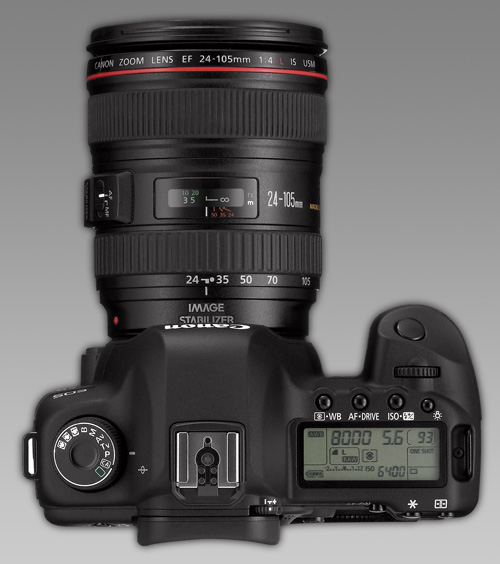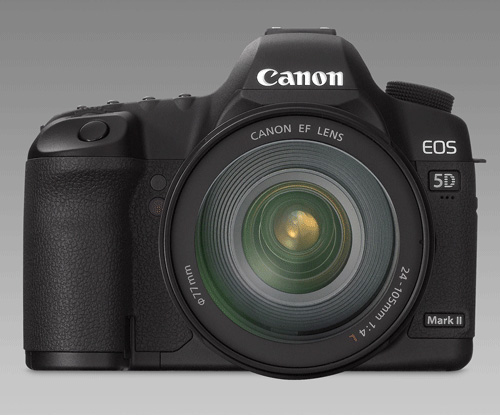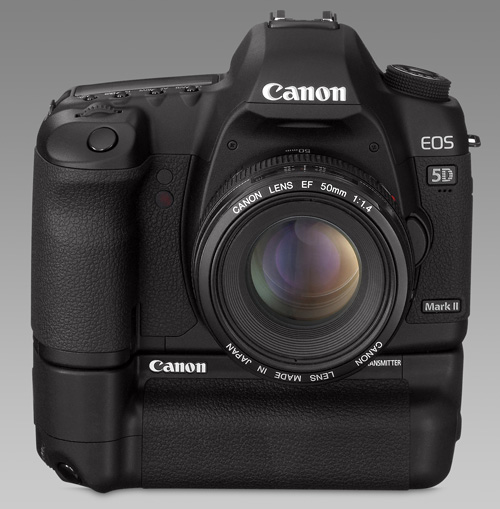Canon Announces 21.1 Megapixel 5D Mark II
by Wesley Fink on September 17, 2008 12:10 AM EST- Posted in
- Digital Camera
The Canon Europe Press Release was organized quite differently and provided more information on the 5D Mark II. It is also interesting that while the 5D Mark II is priced lower than the Sony A900 and Nikon D700 in the US, it is expected to be priced higher than these two models in Europe.
 United Kingdom/ Republic of Ireland, 17 September 2008: Canon announces the full frame, 21.1 Megapixel EOS 5D Mark II: the first EOS with full High Definition video capability. Compact, lightweight and with environmental protection, the successor to the EOS 5D boasts a newly designed Canon CMOS sensor, with ISO sensitivity up to 25,600 for shooting in low light conditions. The new DiG!C 4 processor combines with the improved CMOS sensor to deliver medium format territory image quality at 3.9 frames per second, for up to 310 frames.
United Kingdom/ Republic of Ireland, 17 September 2008: Canon announces the full frame, 21.1 Megapixel EOS 5D Mark II: the first EOS with full High Definition video capability. Compact, lightweight and with environmental protection, the successor to the EOS 5D boasts a newly designed Canon CMOS sensor, with ISO sensitivity up to 25,600 for shooting in low light conditions. The new DiG!C 4 processor combines with the improved CMOS sensor to deliver medium format territory image quality at 3.9 frames per second, for up to 310 frames.

Triggered from Live View Mode, HD video capture allows users to shoot uninterrupted at full 1080 resolution at 30fps – for amazing quality footage with outstanding levels of detail and realism.
The integration of HD movie capability into a high-end 21.1 Megapixel camera opens a multitude of new possibilities for photojournalists and news photographers. With its full frame CMOS sensor and outstanding ISO performance, the EOS 5D Mark II will appeal to any photographer in search of the finest camera equipment available – from studio and wedding to nature and travel photographers.
Enhancements from the original EOS 5D include:
- Addition of Canon’s EOS Integrated Cleaning System, with a new Fluorine coating on the low-pass filter
- Larger 3.0” Clear View LCD with VGA resolution, a 170° angle of view and anti-reflective coatings
- Improved menu system including Quick Control Screen for more direct access to common settings
- Automatic peripheral illumination correction, utilising detailed EF lens information to optimise JPEG images straight out of the camera
- Magnesium alloy construction with additional environmental protection
- UDMA memory card compatibility
“Professional photojournalists and wedding photographers already choose the EOS 5D for its discrete size and outstanding image quality,” said Mogens Jensen, head of Canon Consumer Imaging. “The addition of HD movie recording opens a new chapter for EOS. It creates new possibilities for EOS photographers to capture and share their stories and to stay relevant in a rapidly changing digital landscape.”

Key Specifications:
- New 21.1 Megapixel CMOS sensor with improved EOS Integrated Cleaning System (E.I.C.S.)
- New Full HD 1080 resolution movie recording
- 3.9 frames per second continuous shooting
- High performance DiG!C 4 processor providing superb image quality
- Maximum 310 large JPEG images in a single burst with a UDMA card
- 3.0” VGA (920k dots) Clear View LCD
- ISO 100-6400 (expansion from 50 up to 25,600)
- 9 AF points + 6 Assist AF points
Pricing & Availability:
The EOS 5D Mark II (body only) is available from end of November 2008 priced at £2299.99 / €2999.99 RRP inc. VAT.
The EOS 5D Mark II, EF 24-105mm f4.0L IS USM kit is available from end of November 2008 priced at £3049.99 / €3999.99 RRP inc. VAT.
Additional information

New CMOS sensor
The EOS 5D Mark II newly designed full frame 21.1 Megapixel CMOS sensor features ISO sensitivity from 100-6400, expandable to 50, 12,800 and 25,600. Large 6.4µm2 pixels have been redesigned to capture more light and yield a better signal to noise ratio to ensure lower noise images throughout the ISO range. The full frame sensor has the same dimensions as a frame of 35mm film. This means that wide-angle lenses stay wide, without the change in angle of view associated with smaller sensor cameras. As well as benefiting from finer control over depth of field, photographers moving up to the EOS 5D Mark II full frame format will find the newly designed wide, bright 98% coverage viewfinder a joy to work with.
New DiG!C 4 processor
A new DiG!C 4 processor combined with 14-bit analogue to digital conversion provides smooth gradations in mono-tonal areas such as skies, and highly accurate colour rendition. As well as HD movie shooting, DiG!C 4’s high speed provides for long uninterrupted continuous bursts of large JPEGs, near-instant start-up times and immediate and fast review after shooting. DiG!C 4 also provides for improved noise reduction algorithms, complementing the already low noise images from the EOS 5D Mark II CMOS sensor.
A new DiG!C 4 processor combined with 14-bit analogue to digital conversion provides smooth gradations in mono-tonal areas such as skies, and highly accurate colour rendition. As well as HD movie shooting, DiG!C 4’s high speed provides for long uninterrupted continuous bursts of large JPEGs, near-instant start-up times and immediate and fast review after shooting. DiG!C 4 also provides for improved noise reduction algorithms, complementing the already low noise images from the EOS 5D Mark II CMOS sensor.
HD video capture
The EOS 5D Mark II is Canon’s first D-SLR to incorporate full HD 1920x1080 video capture. Once filming is started from Live View mode, photographers can fire off either single or continuous stills, with video capture continuing after the final frame is captured.
The EOS 5D Mark II is Canon’s first D-SLR to incorporate full HD 1920x1080 video capture. Once filming is started from Live View mode, photographers can fire off either single or continuous stills, with video capture continuing after the final frame is captured.
See everything
A new 3.0” VGA resolution LCD provides a wide 170º angle-of-view, providing plenty of clarity for accurate focus checks in playback. The screen brightness can automatically adjust to suit viewing conditions, extending battery life in low light and improving viewing in bright conditions. A new dedicated Live View button switches modes to display a real-time image on the LCD. This allows EOS 5D Mark II photographers to enjoy simplified shooting from awkward angles. Simple connection to a PC provides easy remote shooting.
A new 3.0” VGA resolution LCD provides a wide 170º angle-of-view, providing plenty of clarity for accurate focus checks in playback. The screen brightness can automatically adjust to suit viewing conditions, extending battery life in low light and improving viewing in bright conditions. A new dedicated Live View button switches modes to display a real-time image on the LCD. This allows EOS 5D Mark II photographers to enjoy simplified shooting from awkward angles. Simple connection to a PC provides easy remote shooting.
Precision focus and metering
A 9-point auto focus system is supported by 6 additional invisible Assist AF points, located inside the spot-metering circle to optimise subject tracking performance in AI SERVO AF mode. For accurate exposure readings in tricky lighting conditions, the spot metering circle covers just 3.5% of the frame.
A 9-point auto focus system is supported by 6 additional invisible Assist AF points, located inside the spot-metering circle to optimise subject tracking performance in AI SERVO AF mode. For accurate exposure readings in tricky lighting conditions, the spot metering circle covers just 3.5% of the frame.
Control
The EOS 5D Mark II redesigned menu system includes a new Quick Control screen, for instant access to the most commonly changed settings. A new Creative Auto mode allows photographers to cede control of key settings to the camera, while retaining control over creative variables such background blur, drive mode and image brightness. Custom user settings allow photographers to switch between two completely different camera setups. This is ideal for changing quickly between two different environments, such as switching from working inside a church without flash to outdoors with fill-flash at a wedding.
The EOS 5D Mark II redesigned menu system includes a new Quick Control screen, for instant access to the most commonly changed settings. A new Creative Auto mode allows photographers to cede control of key settings to the camera, while retaining control over creative variables such background blur, drive mode and image brightness. Custom user settings allow photographers to switch between two completely different camera setups. This is ideal for changing quickly between two different environments, such as switching from working inside a church without flash to outdoors with fill-flash at a wedding.

Accessories
Shooting flexibility is enhanced with a range of new accessories. Shooting capacity can be extended with either the high capacity 1800mAh lithium-ion Battery Pack LP-E6, or Battery Grip BG-E6. A new optional Wireless File Transmitter – the K271 – offers external HDD and GPS compatibility along with the ability to transmit images direct to computer or FTP server, or operate the camera wirelessly. Both the BG-E6 and K271 feature a vertical orientation shutter release and other key controls for comfortable portraiture work, with a substantial grip to help balance the camera when used with long lenses.










38 Comments
View All Comments
Wesley Fink - Wednesday, September 17, 2008 - link
We have added illustrations to answer questions about the 5D Mark II AF module and the ISO Sensitivity compared to the 5D and 1Ds Mark III. The sensor in the 5D Mark II is said by Canon to be the most advanced they have offered in the EOS line so far, and even superior to the 1DS Mark III sensor.Wesley Fink - Wednesday, September 17, 2008 - link
We have added the European Press Release and more 5D Mark II photos from the UK press site to the article. The Canon Europe Press Release was well-organized and provided easy-to-access facts.Spinne - Wednesday, September 17, 2008 - link
I don't think the EOS 1Ds Mk III is going to be sold much longer. They'll probably replace it with a 1Ds Mk III N not too soon after Nikon announces their FF Pro camera. The 1Ds still has many features that the 5D does not, the most important being a 45 pt AF system. All said though, the 5D Mk II does come very close to the current 1Ds Mk III.In terms of the 5D Mk II feature set, I am pumped about the HD movie mode. From the videos that Canon has put out, the quality seems spectacular considering that it's not what you would traditionally buy the caera for - much more than an afterthought. If it is indeed properly done, the level of creativity that it offers is amazing. I have the EF 85mm f/1.8 USm lens and puttogether with a 3200-6400 ISO, I could be shooting videos in the dark with no artificial lighting. The look of natural light video is unique (check the origina Omen movie out to get a feel for what I'm talking about - it uses wide aperture lenses with minimal artificial light extensively). This camera is probaby going to be very revolutionary.
I would really like to see some in depth reviews soon.
n4bby - Wednesday, September 17, 2008 - link
> I would really like to see some in depth reviews soon.just go to dpreview - they always have in-depth previews with 24 hours of announcement, as they get pre-production equipment from Canon/Nikon on NDA. it's also been in the hands of select Canon pro photographers for a number of weeks. the video quality is very, very good.
eternalkp - Wednesday, September 17, 2008 - link
well, the A900 is still the champ so we have to thank sony because canon has to lower the price to compete.21meg for $2700...not bad at all!!!
i am a nikonian and very disappoint in nikon. the d700 sux compare to what's coming ahead.
ncage - Wednesday, September 17, 2008 - link
umm you actually spent that much on a camera body and you think the Sony is better just because it has higher MP. You shouldn't waist your money on a dSLR and just get yourself a High MP Point & Shoot. I am seriously doubting you have a D700 or your one of those rich kids who doesn't know how to use his equipment. I would love to have to D700.melgross - Wednesday, September 17, 2008 - link
I don't see Canon OR Nikon being too concerned by this. So far, both Canon and Nikon have many professional lenses. Sony has none other than the few Zeiss lenses that have come out. The Minolta lenses have been criticized as being pretty old and not designed for digital sensors, while both Canon and Nikon have had a program of re-design and replacement of their many lenses for several years.Still, I believe that Sony is the only real challenger to those two. The other companies are quickly moving to irrelevance.
The new micro 4/3 will be nice for less dedicated shooters, because of its size and weight, and is what the format should have been from the beginning. But it's too late for much else. Pentax doesn't seem to be getting any traction with its more pro bodies.
yyrkoon - Thursday, September 18, 2008 - link
"he new micro 4/3 will be nice for less dedicated shooters, because of its size and weight, and is what the format should have been from the beginning. But it's too late for much else. Pentax doesn't seem to be getting any traction with its more pro bodies. "Being a Nikonian myself, I do not necessarily disagree with everything that you're saying. However, from a technical standpoint, the 4/3 mini format *could* conceivably 'own' the wide angle market. Everything that I have read seems to indicate that because of the closeness of the sensor to the glass that hugely wide images should be possible with minimal to zero distortion. Having said that I am *maybe* average in understanding these technicalities concerning camera, so, I may be wrong(and will have to see where they take us).
strikeback03 - Thursday, September 18, 2008 - link
The registration distance of micro 4/3 is 20mm, so any lens of focal length less than 20mm will be retrofocal (compared to around 40mm for more traditional SLRs). So to match something like the Sigma 12-24 on a full-frame sensor, a lens would have to be wider than 6mm.My guess is that you might see better ultrawides for micro 4/3 than you do for the APS-C class SLRs, as for a given field of view the design would not need to be as retrofocal. Whether they are better than FF will probably depend on how much the parallel illumination of the sensor matters.
Wesley Fink - Wednesday, September 17, 2008 - link
Minolta Professional Grade lenses were labeled G lenses or SSM or both and there are a large number of those in the market. Prices for G glass on the used market have remained very high.Sony carried most of the G and SSM designs over to their own brand, but they released the new badging on these high-end lenses slower than the higher volume lenses. The Carl Zeiss are the newest Pro grade from Sony.
Frankly at the A900 launch event Sony had every one of their current lenses available to try. I think everyone at the event was shocked at the huge number and range of the current Sony Lens selection. I know I was.